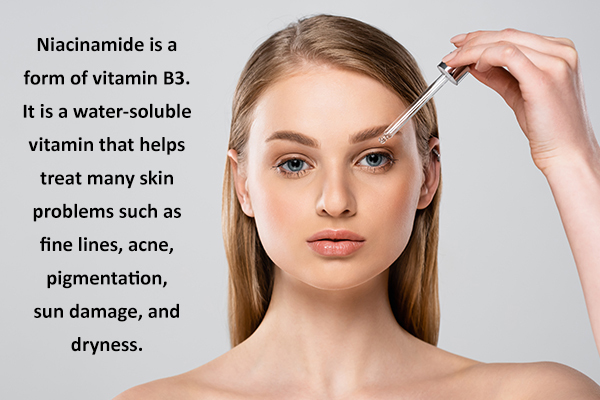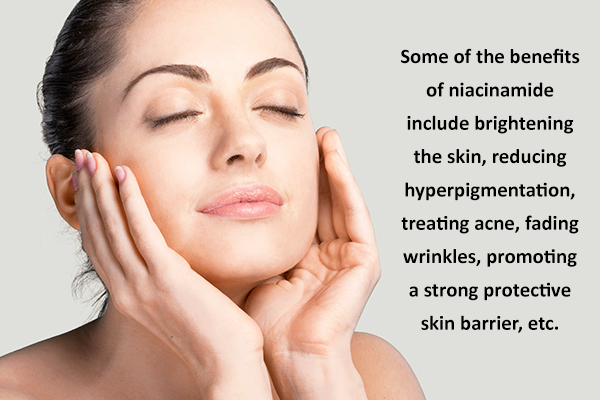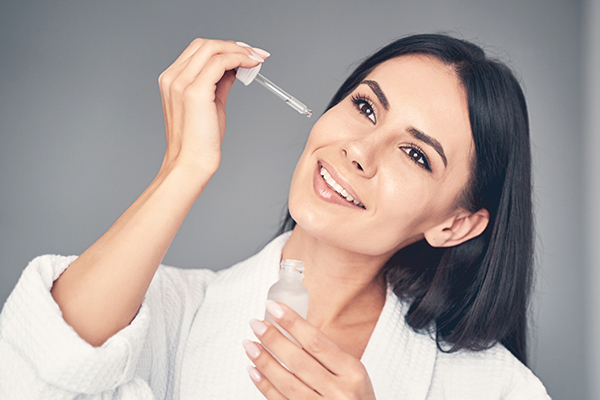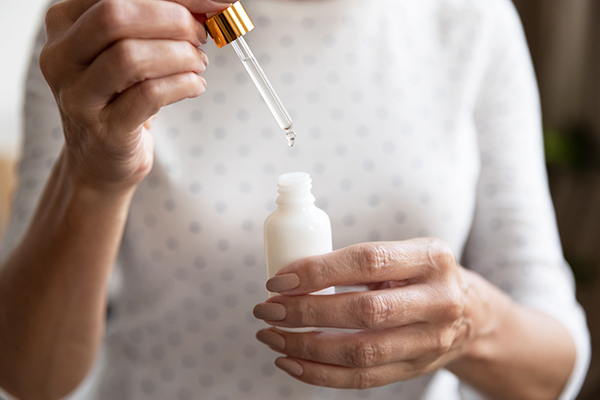In this article:
Serums are an essential part of skin care. From vitamin C to retinol and hyaluronic acid, there are thousands of different skin care ingredients currently available.

Since many of these products contain high concentrations of active components, it is important to use them in a balanced and well-planned routine. Applying the wrong products together can have counterproductive effects on your skin.
Can You Use Niacinamide With Hyaluronic Acid?
Niacinamide and hyaluronic acid are both moisturizing compounds that help your skin retain its water content and stay hydrated. Since both are commonly available in serum formulations and are water based, it is safe to use them together.
Niacinamide is a form of vitamin B3. Topical application of this nutrient can help regulate oil production in the skin and also create a lipid barrier (1)(2) to prevent water loss. It also protects your skin from sun damage caused by UV rays. (3)
Hyaluronic acid, on the other hand, is a substance that naturally occurs in the body and can help hydrate your skin. It has water-binding properties that make it a very potent moisturizer when applied topically to your skin. (4)
Both niacinamide and hyaluronic acid have a similar pH level: 5.0 to 7.0. (5)(6) When used together, it is better to apply hyaluronic acid first as it binds to water molecules and increases water levels in the skin. (7) Applying niacinamide over the hydrated skin will help your skin retain the water longer.
What Is Niacinamide?

As mentioned earlier, niacinamide is a form of vitamin B3. It is a water-soluble vitamin (8) that helps treat many skin problems such as fine lines, acne, pigmentation, sun damage, and dryness.
Fish, yeast, legumes, nuts, and lean meats naturally contain trace amounts of niacinamide while it is added to certain cereals among other foods. This compound is mainly derived from nicotinic acid, which is present in various types of cereals as well as brewer’s yeast.
Niacinamide is most commonly used for its moisturizing properties as it can help prevent water loss by forming a protective barrier on the skin’s outer surface. Using 5%–10% niacinamide serums can help you achieve hydrated and glowing skin.
What Are the Benefits of Niacinamide?
Niacinamide can be used with most other skin care components and usually does not cause any adverse reactions.
Some of the benefits of niacinamide include:

- Brightens the skin
- Reduces hyperpigmentation (9)
- Treats acne
- Fades wrinkles (9)
- Promotes a strong protective skin barrier
- Provides antioxidant effects
- Controls oil production in the skin
What Is Hyaluronic Acid?
Hyaluronic acid (also known as hyaluronan or hyaluronate) is a natural sugar found in the eyes, skin, tissues, and fluid around the joints, most abundantly in the articular cartilage and synovial fluid (SF).
Hyaluronic acid was originally derived from rooster combs, but is currently being manufactured through streptococcal fermentation in most settings.
Hyaluronic acid helps keep your eyes moist and prevents dry eyes. It is a powerful humectant (10) that binds to water molecules and prevents water loss from the body. It can hold water many times its weight.
Hyaluronic acid is produced for commercial use by using bacteria by a process known as biofermentation. (11) It is widely used in many skin care products to moisturize the skin. (12)
What Are the Benefits of Hyaluronic Acid?
Hyaluronic acid is one of the most commonly used moisturizing agents in the skin care industry. Some of the benefits of hyaluronic acid are:
- Increases skin elasticity (13)
- Provides antioxidant effects
- Gives a natural glow to your skin
- Reduces wrinkles and fine lines (9)
- Increases moisture content in the skin, thus providing hydration
How to Layer Niacinamide and Hyaluronic Acid Together?

To effectively use hyaluronic acid and niacinamide together, follow these simple steps:
- Cleanse your face as you normally would.
- Apply a suitable toner.
- Apply a hyaluronic acid serum.
- Wait for 15–20 minutes, and then apply a niacinamide serum.
Tip: You can also use them at different times of the day. For example, apply hyaluronic acid in the morning and niacinamide at night before bedtime.
Who Could Benefit From Using Niacinamide and Hyaluronic Acid Together?
Niacinamide and hyaluronic acid are both hydrating agents that will effectively treat dull complexion, dry, or acne-prone skin, pigmentation, and fine lines. (14)
If you have an oily T-zone (the nose and forehead), you can apply niacinamide to the area to decrease oil production and use hyaluronic acid on the rest of the face.
Make sure you are not allergic to any of these ingredients before applying them to your face.
What Are the Side Effects of Niacinamide and Hyaluronic Acid?
There are a few side effects associated with both these ingredients:
- Niacinamide can cause mild to moderate skin irritation, itching, burning, or redness.
- Side effects of hyaluronic acid are very rare as it is an all-natural component; however, it may cause mild skin irritation in some people.
Most-Asked Questions

Is a 2% hyaluronic acid serum formulation good for the skin?
With hyaluronic acid, a little goes a long way. Look for concentrations between 0.2% and 0.5%; even 1 percent is quite high.
As with most active ingredients, do a patch test and start small, building up to higher percentages.
Is a 4%–5% niacinamide serum concentration good for the skin?
Niacinamide at 4%–5% is the ideal concentration recommended by most dermatologists. Any concentration higher than that may cause skin irritation or allergic reactions in some people.
Final Word
Hyaluronic acid and niacinamide are very powerful hydrating agents that can treat a number of skin issues. They can be used alone or together for double the benefit.
Make sure to perform a patch test before applying any ingredient to your face. Consult a doctor immediately if an allergic reaction occurs.
- Was this article helpful?
- YES, THANKS!NOT REALLY


